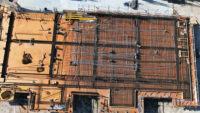The plant resumed secondary treatment operations soon after the incident and the New York Dept. of Environment and Conservation is monitoring water readings based on plant samples, said DEC spokeswoman Stephanie Harrington.
There is no threat to drinking water, a New York Dept. of Health spokesman said.
The LMK audit report findings include:
Vague or missing expansion joint details between the treatment cells.
Numerous leaks at intersecting cell wall joints, likely caused by waterstops that were not installed, improperly installed or damaged during concrete pours.
Vertical construction joints installed at 50-ft intervals on tank and structural walls instead of 25 ft, which is more common in wastewater treatment plants of this size. The wider spacing increased the potential for cracking and leaking from shrinkage stresses, the audit said.
Handrail, ladder and platform construction deficiencies in violation of OSHA and New York State Building Code requirements.
Welding specifications not followed on end caps on process air piping.
Welded stainless steel used instead of standard iron pipe and fittings at a 48-in-dia backwash wastewater suction header.
C&S Engineers Inc. of Syracuse, N.Y., the engineer and construction manager for the $52-million upgrade, has not spent any time getting into a detailed review of the audit, said Bob Duclos, vice president.


Post a comment to this article
Report Abusive Comment